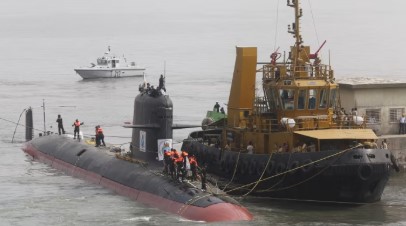A group of hackers has claimed responsibility for a major cyberattack on the French defense company Naval Group, the manufacturer of India’s Scorpene-class submarines.
Massive Cyberattack Targets French Defense Giant Naval Group
According to their claims, the attackers have accessed nearly 1 terabyte (TB) of sensitive data. This reportedly includes the source code of submarine weapon systems—information critical to national defense operations.
Naval Group is a historic French shipbuilder that has produced advanced warships and submarines for France and many partner nations. In particular, India’s six Kaveri-class submarines, developed in partnership with Naval Group, are based on its Scorpene-class design. Moreover, other countries that use Scorpene submarines include Malaysia, Indonesia, and Chile.
Most importantly, this latest incident is not the first time Naval Group has faced cyber threats. To clarify, in 2016, the company suffered a major leak of around 22,000 pages of sensitive documents related to its Scorpene-class submarines. In other words, the information reportedly included detailed combat capabilities of the submarines sold to the Indian Navy.
Japan Approves New Active Cyber Defense System to Combat Cyberattacks
In this recent case, the hackers posted nearly 30 gigabytes (GB) of data online and claimed to have much more in their possession. They also stated that the files belong to Naval Group’s combat management systems for submarines and frigates.
Naval Group Responds to Cybersecurity Claims
Naval Group has responded to the claims by saying it has not detected any unauthorized access to its internal networks so far. In a public statement, the company clarified that an investigation is underway, and they are working closely with the French government.
“Our teams and resources are currently analysing and verifying the authenticity, origin, and ownership of the data as quickly as possible,” the company said.
Cyberattack Hits Russian IT Leader, Financial Institutions at Risk
The defense contractor described the incident as a “reputational attack,” pointing to the current global tensions in politics, trade, and information. Although the hackers claimed to have given the company a 72-hour deadline, Naval Group stated that the attackers have not demanded any ransom.
As part of its internal investigation, Naval Group is actively checking whether someone has stolen any data and whether it came from its systems or another source. The company aims to determine if the hackers’ claims are genuine or simply an attempt to damage its image.
Sensitive Source Code May Be at Risk
One of the most alarming parts of this alleged breach is the release of what appears to be the source code for the weapon systems used on Naval Group submarines. Source code refers to the underlying computer instructions that control how software and digital systems work. In the case of submarines, this could include software for weapons, communications, and navigation.
If hackers gain access to such code, they could understand how the system works from the inside. They might learn about its security systems, passwords, and logic. Worse, they might find weaknesses or even add new ones for future attacks.
Although the company has said its systems remain secure and no breach has been confirmed, the threat is serious. Information like this can help other hackers or even rival nations understand sensitive military technology.
🔐 Ukraine wipes Gazprom’s core systems in massive cyber blitz—servers destroyed, 390 branches hit
Authorities have not officially identified the attackers. No one has clearly established the motive yet. While no one has confirmed whether the full 1TB of data exists, the hackers have already released 30GB, which raises significant concerns. They may have uploaded the leaked data to public sites or shared it on hidden parts of the internet, where bad actors could access it.
This situation adds pressure on cybersecurity teams in the defense sector, especially as many countries rely on Naval Group’s expertise and engineering for their submarines and ships.

